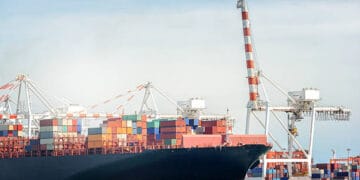As the maritime industry enters a new phase, the National Retail Federation (NRF) and Hackett Associates have revised their import volume forecasts based on August figures, indicating that the peak for maritime imports has passed. The slowdown in volumes is attributed to several factors, including shippers’ early inventory stocking to mitigate potential labor disruptions, leading to a more subdued holiday season.
Jonathan Gold, NRF Vice President for Supply Chain and Customs Policy, commented on the forecast, highlighting that shippers had bolstered their inventory earlier in the year. This strategic move aimed to preemptively address any labor-related disruptions, which has consequently led to a deceleration in maritime flows.
The impact of this slowdown in import volumes was particularly noticeable in August, with the nation’s top ports experiencing a decline in total cargo volumes for August 2023 compared to the previous year. According to data compiled by Supply Chain Dive, 11 out of the top 12 U.S. container ports reported a dip in total cargo volumes for that month. Remarkably, the Port of Los Angeles was the sole exception, registering an annual increase in total twenty-foot equivalent units (TEUs) processed for August.
In total, U.S. ports handled approximately 4 million TEUs in August, marking a 3% increase from July but a 15% decrease compared to the same month the previous year.
The decline in annual volumes comes after a record-breaking year for ports in 2022. Despite retailers’ efforts to destock, ports emphasized that current volumes remain on par with pre-pandemic levels.
Over the first eight months of the year, the top 12 U.S. ports collectively managed 30.3 million TEUs. Although this figure falls slightly short of the 31.1 million TEUs handled from January to August 2019, it represents a marginal increase compared to the 30 million TEUs handled during the first eight months of 2018.
Looking ahead, Jonathan Gold from the NRF anticipates that “cargo volumes will still be strong for the remainder of the year, but not as high as we expected a month ago.”
Hackett Associates also noted that shipping lines are proactively adjusting their operations to align with the lighter volumes anticipated by the year’s end. This adjustment includes slowing down ships to reduce capacity without having to take vessels out of service, particularly as new and larger vessels ordered during the peak of demand are being delivered.
As the maritime industry adapts to changing dynamics and recalibrates its strategies, the revised forecasts underscore the importance of flexibility and responsiveness within the supply chain, especially as the holiday season approaches.
Find the latest supply chain report news at The Supply Chain Report. For international trade tools, see ADAMftd.com.
#MaritimeIndustry #NRF #HackettAssociates #USPorts #ShippingForecast #CargoVolumes #SupplyChainForecast #LaborDisruptions #PeakShipping #HolidaySeason #PortOfLosAngeles #ShippingAdjustments #SupplyChainResilience #InventoryStocking #TEUs #PortVolumes #MaritimeTrends #ShippingSlowdown #SupplyChainFlexibility

















